《Java多线程编程核心技术》读后感(九)
当interrupt方法遇到wait方法
当线程呈wait()状态时,调用线程对象的interrupt()会出现InterruptedException异常
package Third;
public class Service {
public void testMethod(Object lock) {
try {
synchronized (lock) {
System.out.println("begin wait()");
lock.wait();
System.out.println(" end wait()");
}
} catch (InterruptedException e) {
e.printStackTrace();
System.out.println("出现异常了,因为呈wait状态的线程被interrupt了!");
}
}
}
package Third;
public class ThreadA extends Thread {
private Object lock;
public ThreadA(Object lock) {
super();
this.lock = lock;
}
@Override
public void run() {
Service service = new Service();
service.testMethod(lock);
}
}
package Third;
public class Test {
public static void main(String[] args) {
try {
Object lock = new Object();
ThreadA a = new ThreadA(lock);
a.start();
Thread.sleep(5000);
a.interrupt();
} catch (InterruptedException e) {
e.printStackTrace();
}
}
}

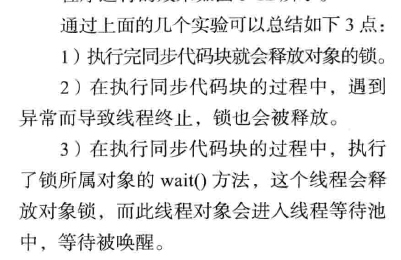
只通知一个线程
调用方法notify()一次只随机通知一个线程进行唤醒
package Third;
public class Service {
public void testMethod(Object lock) {
try {
synchronized (lock) {
System.out.println("begin wait() ThreadName="
+ Thread.currentThread().getName());
lock.wait();
System.out.println(" end wait() ThreadName="
+ Thread.currentThread().getName());
}
} catch (InterruptedException e) {
e.printStackTrace();
}
}
}
package Third;
public class ThreadA extends Thread {
private Object lock;
public ThreadA(Object lock) {
super();
this.lock = lock;
}
@Override
public void run() {
Service service = new Service();
service.testMethod(lock);
}
}
package Third;
public class ThreadB extends Thread {
private Object lock;
public ThreadB(Object lock) {
super();
this.lock = lock;
}
@Override
public void run() {
Service service = new Service();
service.testMethod(lock);
}
}
package Third;
public class ThreadC extends Thread {
private Object lock;
public ThreadC(Object lock) {
super();
this.lock = lock;
}
@Override
public void run() {
Service service = new Service();
service.testMethod(lock);
}
}
package Third;
public class NotifyThread extends Thread {
private Object lock;
public NotifyThread(Object lock) {
super();
this.lock = lock;
}
@Override
public void run() {
synchronized (lock) {
lock.notify();
}
}
}
package Third;
public class Test {
public static void main(String[] args) throws InterruptedException {
Object lock = new Object();
ThreadA a = new ThreadA(lock);
a.start();
ThreadB b = new ThreadB(lock);
b.start();
ThreadC c = new ThreadC(lock);
c.start();
Thread.sleep(1000);
NotifyThread notifyThread = new NotifyThread(lock);
notifyThread.start();
}
}

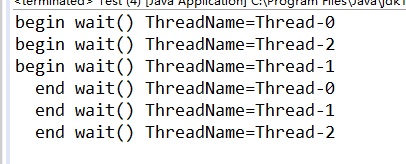
唤醒所有线程
package Third;
public class NotifyThread extends Thread {
private Object lock;
public NotifyThread(Object lock) {
super();
this.lock = lock;
}
@Override
public void run() {
synchronized (lock) {
lock.notifyAll();
}
}
}

wait(long)的使用
功能是等待某一时间内是否有线程对锁进行唤醒,如果超过这个时间则自动唤醒

当然也可以由其他线程进行唤醒
package Third;
public class MyRunnable {
static private Object lock = new Object();
static private Runnable runnable1 = new Runnable() {
@Override
public void run() {
try {
synchronized (lock) {
System.out.println("wait begin timer="
+ System.currentTimeMillis());
lock.wait(5000);
System.out.println("wait end timer="
+ System.currentTimeMillis());
}
} catch (InterruptedException e) {
e.printStackTrace();
}
}
};
static private Runnable runnable2 = new Runnable() {
@Override
public void run() {
synchronized (lock) {
System.out.println("notify begin timer="
+ System.currentTimeMillis());
lock.notify();
System.out.println("notify end timer="
+ System.currentTimeMillis());
}
}
};
public static void main(String[] args) throws InterruptedException {
Thread t1 = new Thread(runnable1);
t1.start();
Thread.sleep(3000);
Thread t2 = new Thread(runnable2);
t2.start();
}
}

通知过早
package Third;
public class MyRun {
private String lock = new String("");
private Runnable runnableA = new Runnable() {
@Override
public void run() {
try {
synchronized (lock) {
System.out.println("begin wait");
lock.wait();
System.out.println("end wait");
}
} catch (InterruptedException e) {
e.printStackTrace();
}
}
};
private Runnable runnableB = new Runnable() {
@Override
public void run() {
synchronized (lock) {
System.out.println("begin notify");
lock.notify();
System.out.println("end notify");
}
}
};
public static void main(String[] args) throws InterruptedException {
MyRun run = new MyRun();
Thread a = new Thread(run.runnableA);
a.start();
Thread b = new Thread(run.runnableB);
b.start();
}
}

package Third;
public class MyRun {
private String lock = new String("");
private Runnable runnableA = new Runnable() {
@Override
public void run() {
try {
synchronized (lock) {
System.out.println("begin wait");
lock.wait();
System.out.println("end wait");
}
} catch (InterruptedException e) {
e.printStackTrace();
}
}
};
private Runnable runnableB = new Runnable() {
@Override
public void run() {
synchronized (lock) {
System.out.println("begin notify");
lock.notify();
System.out.println("end notify");
}
}
};
public static void main(String[] args) throws InterruptedException {
MyRun run = new MyRun();
Thread a = new Thread(run.runnableA);
a.start();
Thread.sleep(100);
Thread b = new Thread(run.runnableB);
b.start();
}
}
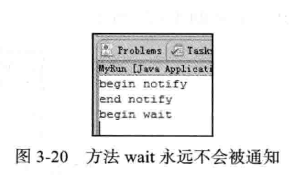
如果先通知了,则wait方法也就没有必要执行了
package Third;
public class MyRun {
private String lock = new String("");
private boolean isFirstRunB = false;
private Runnable runnableA = new Runnable() {
@Override
public void run() {
try {
synchronized (lock) {
while (isFirstRunB == false) {
System.out.println("begin wait");
lock.wait();
System.out.println("end wait");
}
}
} catch (InterruptedException e) {
e.printStackTrace();
}
}
};
private Runnable runnableB = new Runnable() {
@Override
public void run() {
synchronized (lock) {
System.out.println("begin notify");
lock.notify();
System.out.println("end notify");
isFirstRunB = true;
}
}
};
public static void main(String[] args) throws InterruptedException {
MyRun run = new MyRun();
Thread b = new Thread(run.runnableB);
b.start();
Thread.sleep(100);
Thread a = new Thread(run.runnableA);
a.start();
}
}

等待wait条件发生变化
在使用wait/notify模式时,还需要注意另外一种情况。也就是wait等待的条件发生了变化,也容易造成程序逻辑混乱
package Third;
public class Add {
private String lock;
public Add(String lock) {
super();
this.lock = lock;
}
public void add() {
synchronized (lock) {
ValueObject.list.add("anyString");
lock.notifyAll();
}
}
}
package Third;
public class Subtract {
private String lock;
public Subtract(String lock) {
super();
this.lock = lock;
}
public void subtract() {
try {
synchronized (lock) {
if (ValueObject.list.size() == 0) {
System.out.println("wait begin ThreadName="
+ Thread.currentThread().getName());
lock.wait();
System.out.println("wait end ThreadName="
+ Thread.currentThread().getName());
}
ValueObject.list.remove(0);
System.out.println("list size=" + ValueObject.list.size());
}
} catch (InterruptedException e) {
e.printStackTrace();
}
}
}
package Third; import java.util.ArrayList;
import java.util.List; public class ValueObject { public static List list = new ArrayList(); }
package Third;
public class ThreadAdd extends Thread {
private Add p;
public ThreadAdd(Add p) {
super();
this.p = p;
}
@Override
public void run() {
p.add();
}
}
package Third;
public class ThreadSubtract extends Thread {
private Subtract r;
public ThreadSubtract(Subtract r) {
super();
this.r = r;
}
@Override
public void run() {
r.subtract();
}
}
package Third;
public class Run {
public static void main(String[] args) throws InterruptedException {
String lock = new String("");
Add add = new Add(lock);
Subtract subtract = new Subtract(lock);
ThreadSubtract subtract1Thread = new ThreadSubtract(subtract);
subtract1Thread.setName("subtract1Thread");
subtract1Thread.start();
ThreadSubtract subtract2Thread = new ThreadSubtract(subtract);
subtract2Thread.setName("subtract2Thread");
subtract2Thread.start();
Thread.sleep(1000);
ThreadAdd addThread = new ThreadAdd(add);
addThread.setName("addThread");
addThread.start();
}
}
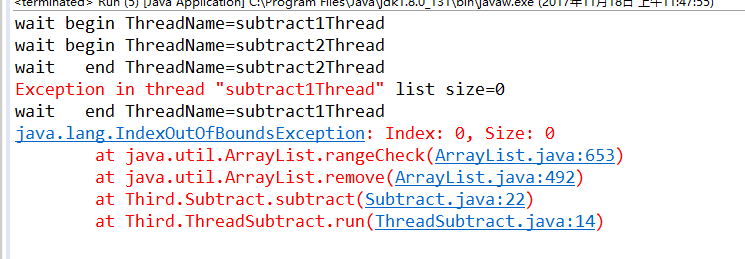

package Third;
public class Subtract {
private String lock;
public Subtract(String lock) {
super();
this.lock = lock;
}
public void subtract() {
try {
synchronized (lock) {
while (ValueObject.list.size() == 0) {
System.out.println("wait begin ThreadName="
+ Thread.currentThread().getName());
lock.wait();
System.out.println("wait end ThreadName="
+ Thread.currentThread().getName());
}
ValueObject.list.remove(0);
System.out.println("list size=" + ValueObject.list.size());
}
} catch (InterruptedException e) {
e.printStackTrace();
}
}
}

生产者/消费者模式实现
1、一生产与一消费:操作值
package Third; //生产者
public class P { private String lock; public P(String lock) {
super();
this.lock = lock;
} public void setValue() {
try {
synchronized (lock) {
if (!ValueObject.value.equals("")) {
lock.wait();
}
String value = System.currentTimeMillis() + "_"
+ System.nanoTime();
System.out.println("set的值是" + value);
ValueObject.value = value;
lock.notify();
} } catch (InterruptedException e) {
e.printStackTrace();
}
} }
package Third; //消费者
public class C { private String lock; public C(String lock) {
super();
this.lock = lock;
} public void getValue() {
try {
synchronized (lock) {
if (ValueObject.value.equals("")) {
lock.wait();
}
System.out.println("get的值是" + ValueObject.value);
ValueObject.value = "";
lock.notify();
} } catch (InterruptedException e) {
e.printStackTrace();
}
} }
package Third;
public class ValueObject {
public static String value = "";
}
package Third;
public class ThreadP extends Thread {
private P p;
public ThreadP(P p) {
super();
this.p = p;
}
@Override
public void run() {
while (true) {
p.setValue();
}
}
}
package Third;
public class ThreadC extends Thread {
private C r;
public ThreadC(C r) {
super();
this.r = r;
}
@Override
public void run() {
while (true) {
r.getValue();
}
}
}
package Third;
public class Run {
public static void main(String[] args) {
String lock = new String("");
P p = new P(lock);
C r = new C(lock);
ThreadP pThread = new ThreadP(p);
ThreadC rThread = new ThreadC(r);
pThread.start();
rThread.start();
}
}

在控制台中打印的日志get和set是交替运行的
2、多生产与多消费:操作值-假死
“”假死“”的现象其实就是线程进入waiting等待状态,如果全部线程都进入waiting状态,则程序就不再执行任何业务功能了,整个项目呈停止状态
package Third; //消费者
public class C { private String lock; public C(String lock) {
super();
this.lock = lock;
} public void getValue() {
try {
synchronized (lock) {
while (ValueObject.value.equals("")) {
System.out.println("消费者 "
+ Thread.currentThread().getName() + " WAITING了☆");
lock.wait();
}
System.out.println("消费者 " + Thread.currentThread().getName()
+ " RUNNABLE了");
ValueObject.value = "";
lock.notify();
} } catch (InterruptedException e) {
e.printStackTrace();
}
} }
package Third; //生产者
public class P { private String lock; public P(String lock) {
super();
this.lock = lock;
} public void setValue() {
try {
synchronized (lock) {
while (!ValueObject.value.equals("")) {
System.out.println("生产者 "
+ Thread.currentThread().getName() + " WAITING了★");
lock.wait();
}
System.out.println("生产者 " + Thread.currentThread().getName()
+ " RUNNABLE了");
String value = System.currentTimeMillis() + "_"
+ System.nanoTime();
ValueObject.value = value;
lock.notify();
} } catch (InterruptedException e) {
e.printStackTrace();
}
} }
package Third;
public class ValueObject {
public static String value = "";
}
package Third;
public class ThreadP extends Thread {
private P p;
public ThreadP(P p) {
super();
this.p = p;
}
@Override
public void run() {
while (true) {
p.setValue();
}
}
}
package Third;
public class ThreadC extends Thread {
private C r;
public ThreadC(C r) {
super();
this.r = r;
}
@Override
public void run() {
while (true) {
r.getValue();
}
}
}
package Third;
public class Run {
public static void main(String[] args) throws InterruptedException {
String lock = new String("");
P p = new P(lock);
C r = new C(lock);
ThreadP[] pThread = new ThreadP[2];
ThreadC[] rThread = new ThreadC[2];
for (int i = 0; i < 2; i++) {
pThread[i] = new ThreadP(p);
pThread[i].setName("生产者" + (i + 1));
rThread[i] = new ThreadC(r);
rThread[i].setName("消费者" + (i + 1));
pThread[i].start();
rThread[i].start();
}
Thread.sleep(5000);
Thread[] threadArray = new Thread[Thread.currentThread()
.getThreadGroup().activeCount()];
Thread.currentThread().getThreadGroup().enumerate(threadArray);
for (int i = 0; i < threadArray.length; i++) {
System.out.println(threadArray[i].getName() + " "
+ threadArray[i].getState());
}
}
}
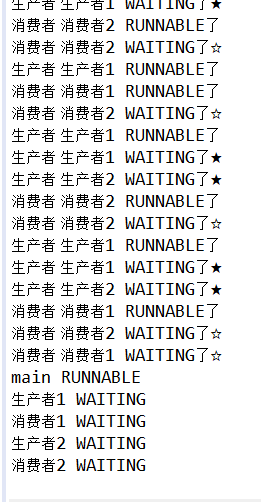

假死出现的主要原因是有可能连续唤醒同类
多生产与多消费:操作值
将上面项目的P.java和C.java文件中的notify()改成notifyAll()即可,不光通知同类线程,也包括异类
《Java多线程编程核心技术》读后感(九)的更多相关文章
- Java多线程编程核心技术---学习分享
继承Thread类实现多线程 public class MyThread extends Thread { @Override public void run() { super.run(); Sys ...
- Java多线程编程核心技术---对象及变量的并发访问(二)
数据类型String的常量池特性 在JVM中具有String常量池缓存的功能. public class Service { public static void print(String str){ ...
- Java多线程编程核心技术
Java多线程编程核心技术 这本书有利于对Java多线程API的理解,但不容易从中总结规律. JDK文档 1. Thread类 部分源码: public class Thread implements ...
- 《Java多线程编程核心技术》推荐
写这篇博客主要是给猿友们推荐一本书<Java多线程编程核心技术>. 之所以要推荐它,主要因为这本书写得十分通俗易懂,以实例贯穿整本书,使得原本抽象的概念,理解起来不再抽象. 只要你有一点点 ...
- 《java多线程编程核心技术》(一)使用多线程
了解多线程 进程和多线程的概念和线程的优点: 提及多线程技术,不得不提及"进程"这个概念.百度百科对"进程"的解释如下: 进程(Process)是计算机中的程序 ...
- 《Java 多线程编程核心技术》- 笔记
作为业务开发人员,能够在工作中用到的技术其实不多.虽然平时老是说什么,多线程,并发,注入,攻击!但是在实际工作中,这些东西不见得用得上.因为,我们用的框架已经把这些事做掉了. 比如web开发,外面有大 ...
- Thread.currentThread()和this的区别——《Java多线程编程核心技术》
前言:在阅读<Java多线程编程核心技术>过程中,对书中程序代码Thread.currentThread()与this的区别有点混淆,这里记录下来,加深印象与理解. 具体代码如下: pub ...
- Java多线程编程核心技术(三)多线程通信
线程是操作系统中独立的个体,但这些个体如果不经过特殊的处理就不能成为一个整体.线程间的通信就是成为整体的必用方案之一,可以说,使线程间进行通信后,系统之间的交互性会更强大,在大大提高CPU利用率的同时 ...
- Java多线程编程核心技术(二)对象及变量的并发访问
本文主要介绍Java多线程中的同步,也就是如何在Java语言中写出线程安全的程序,如何在Java语言中解决非线程安全的相关问题.阅读本文应该着重掌握如下技术点: synchronized对象监视器为O ...
- Java多线程编程核心技术(一)Java多线程技能
1.进程和线程 一个程序就是一个进程,而一个程序中的多个任务则被称为线程. 进程是表示资源分配的基本单位,线程是进程中执行运算的最小单位,亦是调度运行的基本单位. 举个例子: 打开你的计算机上的任务管 ...
随机推荐
- CSS定位细节
记住此三句话,很好的解决了关于浮动方面的问题: 1.浮动的元素对于没有设置浮动的元素来说是不存在的,浮动的元素将会覆盖没有浮动的元素 如图:先让d1浮动在left ,d2位置不浮动,d1覆盖了d2之上 ...
- 使用active mq
1 windows下使用active mq 1.1 下载active mq 1.2 点击根目录\bin\win64\activemq.bat运行 1.3 登陆查看 http://localhost:8 ...
- iOS改变UIAlertView、UIActionSheet、UIAlertController系统字体颜色
废话不多说,直接上代码,效果是最好的说服力 1.改变UIAlertView字体颜色 [UIView appearance].tintColor = [UIColor greenColor]; 个人还是 ...
- JS性能优化——DOM编程
浏览器中的DOM 天生就慢 DOM是个与语言无关的API,它在浏览器中的接口却是用JavaScript实现的.客户端脚本编程大多数时候是在个底层文档打交道,DOM就成为现在JavaScript编码中 ...
- 使用 Spring 容器管理 Filter
当我们用Filter时,往往需要使用一些辅助的service,在普通的java中,只要声明(set,get方法)后在spring-application配置文件中配置就可以了,但是由于Filter与L ...
- 在VS2015中的SDL2.0开发环境搭建
写本文的目的在于使用网络上的教程及官方的教程(如:http://www.willusher.io/sdl2%20tutorials/2013/08/15/lesson-0-visual-studio) ...
- interceptors
<mvc:interceptors> <mvc:interceptor> <mvc:mapping path="/**"/> <bean ...
- Uncaught TypeError: Illegal invocation解决
jquery中报了这个错,仔细一看,有个使用ajax的地方,其中有个参数是从页面某个文本框获取的,本应该 $('#id').value ,被我写成了 $('id') .所以报错,目前已解决.
- oracle_sql的用法?
本机连接oracle 数据库?打开cmd ----> 不同的用户有不同的用户名密码 ----> sqlplus scott/tiger(安装oracle数据库预留的用户)---- 回车 - ...
- apace搭建站点
Listen 127.0.0.1:3310<VirtualHost *:3306> ServerName 127.0.0.1:3306 DocumentRoot "F:/Baid ...
